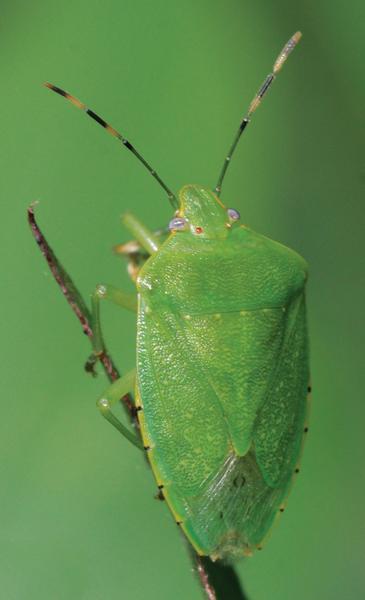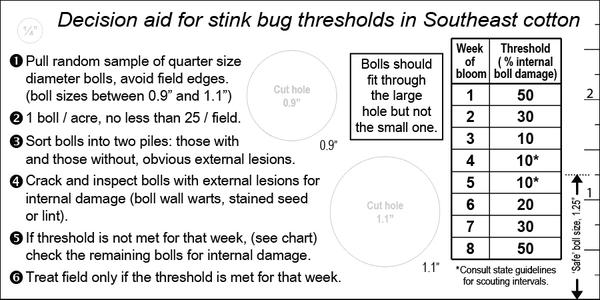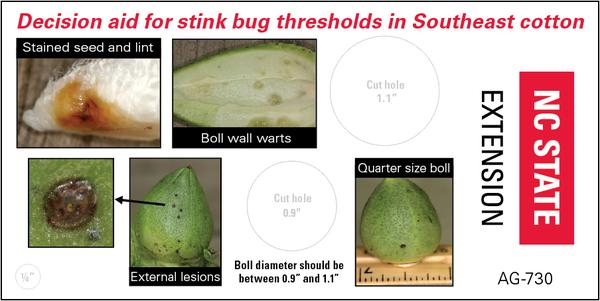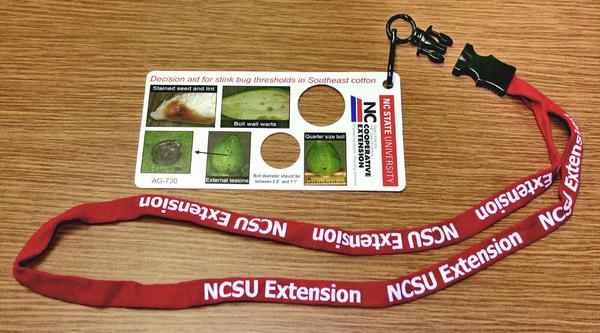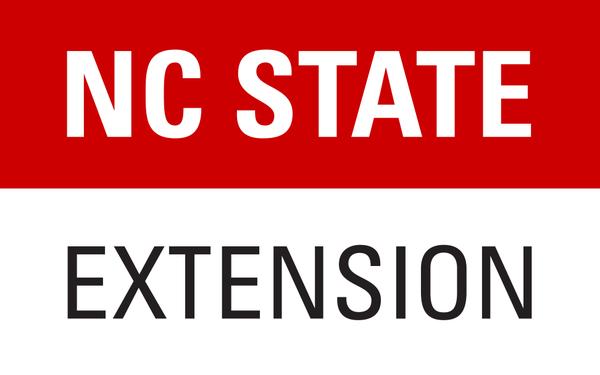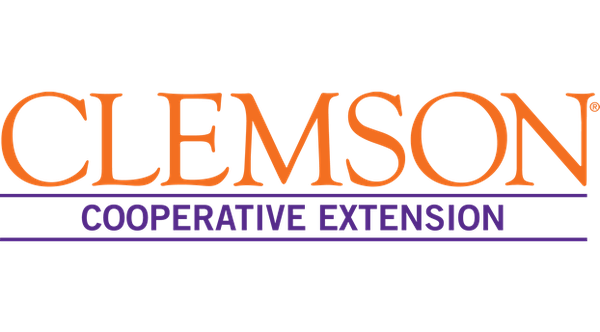Cotton growers in the Southeast can use a pocket-size scouting decision aid to assess and manage stink bug damage based on thresholds for different cotton growth stages.
Stink Bug Scouting Decision Aid
A pocket-size scouting decision aid was developed for use in the Southeast to encourage (1) enhanced adoption of stink bug scouting in cotton, (2) better field identification of stink bug-induced boll damage symptoms, and (3) use of recommended scouting procedures. This publication describes the decision aid and how to use it. The aid relies on the latest dynamic threshold for stink bugs in cotton based on week of bloom. It provides the following scouting aids:
- A “dynamic threshold by week of bloom” table
- Recommended scouting procedures
- Measuring holes to help select the correct boll size range for damage assessments
- Images of internal and external stink bug-induced boll damage.
The aid should greatly improve stink bug management because the dynamic threshold is based on the cotton growth stages when the crop is most susceptible to stink bug damage. It relies on lower thresholds during weeks of maximum susceptibility (weeks 3 through 5 of the bloom period) and higher thresholds during stages of lower vulnerability (weeks 1 to 2 and weeks 6 to 9 of the bloom period).
Description and Use
The front (Figure 1) side of the 3- by 6-inch decision aid provides recommended scouting procedures:
1. Select a random sample of the correct size bolls.
2. Assess an adequate number of bolls.
3. Sort the bolls into two piles, those with and those without obvious external damage lesions.
4. Crack bolls between the thumb and forefinger or cut them open with a knife and inspect all internal boll wall surfaces for internal warts (not just areas visible from the initial crushing or from the initial knife cut), and examine all locks for stained lint. (Helpful hint: crack and inspect bolls with obvious external lesions first to determine if the internal damage threshold is met, as bolls with external lesions are more likely to be damaged internally; assessing these bolls first can save time.)
5. If the threshold is not met, check the remaining bolls for internal damage.
6. Treat only if the threshold has been met for that week.
The measuring holes provide an efficient way to select correctly sized bolls. Cotton scouts should target bolls with an outside diameter between 0.9 to 1.1 inches. Bolls of this size correlate best with recent stink bug damage.
The front side also lists the recommended dynamic threshold by week of bloom. The asterisks for weeks 4 and 5 of the bloom period permit nuances in scouting frequency recommendations by the various southeastern states.
The reverse side of the aid provides images to help properly identify stink bug damage: internal warts, and stained lint; and external damage lesions (Figure 2). As explained in recommendation 3, above, external damage symptoms may be used to sort the pulled bolls into two groups.
Each decision aid is fitted with a lanyard that can be worn around the scout’s neck. The lanyard has a quick disconnect adjacent to the aid (Figure 3) for removing the aid to size bolls.
Resources
For stink bug scouting details and additional cotton insect management information, see these websites:
North Carolina State University Cotton Insect Scouting Guide
Acknowlegment
Research support provided through grants from Cotton Incorporated (2005 to 2011) and through a Southern Regional IPM Center Capstone Grant (2010).
This publication is a revision of an earlier version. The authors would like to thank Jack Bacheler (NC State), D. Ames Herbert (Virginia Tech), Jeremy Greene (Clemson University), Phillip Roberts (University of Georgia), Michael Toews (University of Georgia), Eric Blinka (Monsanto Company), and Ron Smith (Auburn University), and Sally Taylor (Virginia Tech) for their earlier contributions.
Publication date: March 27, 2024
AG-730
N.C. Cooperative Extension prohibits discrimination and harassment regardless of age, color, disability, family and marital status, gender identity, national origin, political beliefs, race, religion, sex (including pregnancy), sexual orientation and veteran status.

